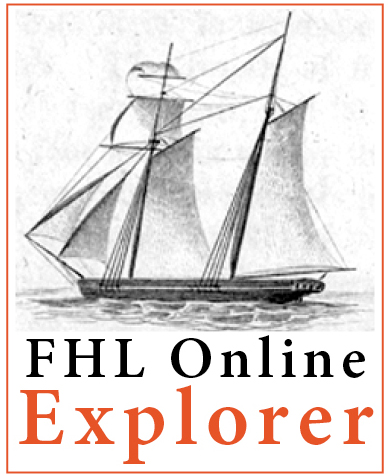An online project under the direction of the CAPE ANN MUSEUM
Lesson plans for teachers
Fitz Henry Lane Online Educational Resources
Setting Sail for Distant Horizons: Cape Ann Captains and their Cargoes
Lesson plan 3C: Grades 9-12
 |
Fitz Henry Lane Online Lessons are designed to encourage students to make observations while looking closely at artwork and archival documents, to carry out their own investigations into the nineteenth-century world of an artist and his surroundings, and to foster critical thinking at multiple levels. Lessons were designed with a 30-45 minute timeframe in mind for observation and group discussion. Assessments were designed for completion with the teacher during additional class time or independently at home. |
Purpose
What can a lithograph teach students about being a global citizen in the nineteenth century? Artist Fitz Henry Lane lived at a time when many Americans, especially those living in a port city, were off exploring the world, delivering and receiving goods, having adventures, and living in a global community. This lesson will utilize primary sources such as paintings, news articles and personal accounts to learn more about life in the nineteenth century.
Objectives
- Students will discuss and answer the question: what does it mean to be a global citizen in the nineteenth century?
- Students will discuss and answer the question: what are examples of “good” global citizenship today?
- Students will examine primary and secondary sources of the same account.
- Students will compare and contrast events from the nineteenth century with similar events today.
Materials
Access to Fitz Henry Lane Online for each student
Paper for writing or computers for word processing
Access to other websites for researching current events
Procedures
Please note: it is recommended that the teacher preview the site including the lithographs, paintings, interactive features and historical materials for the lesson in advance.
Ask students to define what it means to be a global citizen of the world today? A global citizen is someone who identifies with being part of an emerging world community and whose actions contribute to building this community's values and practices.
Nineteenth-century sea captains could be considered global citzens because their vessels brought them to places all over the world. People living in seaports had access to information and vessels from other countries more so then those living inland.
Explain to the class that they will be using Fitz Henry Lane Online to help them answer the essential question: What did it mean to be a global citzen in the nineteenth century? How is this similar or different from being a global citizen today?
Access Fitz Henry Lane Online Departure of the "Jamestown" for Cork, Ireland, 1847 (inv. 475)

Departure of the "Jamestown" for Cork, Ireland, 1847 (inv. 475)
As you zoom in and around the lithograph, start to think about what this image might tell about global citizens in the nineteenth century. Ask the students to make observations about what they see in the lithograph.
Click the link below to access a primary source account of this particular voyage of the Jamestown.
The Voyage of the "Jamestown" on her Errand of Mercy.
Robert Bennet Forbes, Boston: Eastburn's Press, 1847
Have the students read the PDF of the booklet The Voyage of the Jamestown, written by the captain of the ship, R.B. Forbes. Together read the introductory paragraph. Next have students explore the related historical materials for the Jamestown and Robert B. Forbes, composing a picture of what it meant to be a global citizen in the nineteenth century. Students should write down their thoughts on one half of the venn diagram on Worksheet 7.
Assessment
Place students in pairs or small groups and ask them to discuss the question: what does it mean to be a global citizen today? How is this similar or different from being a global citizen in the nineteenth century as seen in the example of Robert B. Forbes? Students can use other resources to answer this question and then write down their thoughts to complete the venn diagram on Worksheet 7. Each student is responsible for writing a short informative text about global citizens, yesterday and today.
Extension
Have students launch a public awareness campaign around their school to promote the benefits of having a global perspective.
Standards
Massachusetts Social Studies
USI.28
Explain the emergence and impact of the textile industry in New England and industrial growth throughout antebellum America.
A. the technological improvements and inventions that contributed to industrial growth
B. the causes and impact of the wave of immigration from Northern Europe to America in the 1840s and 1850s
C. the rise of a business class of merchants and manufacturers
D. the roles of women in New England textile factories.
Common Core Standards
CCSRH.9 – 10.9
Compare and contrast treatments of the same topic in several primary and secondary sources.
CCS WHST. 9 – 10.2
Write informative/explanatory texts, including the narration of historical events, scientific procedures/experiments, or technical processes.
CCS WHST.9-10.8
Gather relevant information from multiple authoritative print and digital sources, using advanced searches effectively; assess the usefulness of each source in answering the research question; integrate information into the text selectively to maintain the flow of ideas, avoiding plagiarism and following a standard format for citation.
This lesson includes practicing review of social standards from previous grades.